With the best graphics cards better than ever, now’s perhaps the best time to take one of them home. Nvidia Turing powerhouses like the RTX 2080 Ti and RTX 2060 have been on the shelves for a while now, to start. In addition, AMD recently unleashed several of its next generation AMD Navi GPUs on July 7th. It’s, without a doubt, an exciting time for graphic cards.
Still, this brings up an excellent question: is it worth it to shell out some serious cash on a pricey flagship? Or, is the more budget-friendly graphics cards, like the Nvidia GeForce GTX 1660, a better value? Keep in mind that the best graphics cards for you will depend on what kind of PC want to build. Which ever one’s the best match for you, you want the best graphics cards that will let you play the best PC games from Rage 2 to The Division 2.
We know that finding the perfect GPU can be a confusing process, so we are here to help. We’ve put together a list of the best graphics cards that are currently on the market, each of which have been tested and reviewed by us at TechRadar. Before you go out to pick up that shiny new graphics card, let us help you decide on the perfect one for your setup.
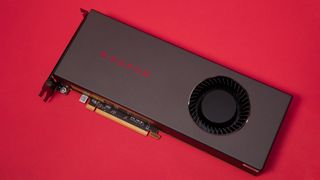
Image credit: TechRadar
(Image credit: Future)
1. AMD Radeon RX 5700
The best graphics card for most people
Stream Processors: 2,304 | Core Clock: 1,465 MHz (1,725 MHz boost) | Memory: 8GB GDDR6 | Memory Clock: 14Gbps | Power Connectors: 1 x 8-pin and 1 x 6-pin | Outputs: 1 x DisplayPort 1.4 with DSC, 1 x HDMI with 4K60 Support
Excellent performance
Affordable
No ray tracing
This absolute powerhouse of a graphics card has barely hit the streets, and it’s already topping our list of the best graphics card, knocking reigning champion and its direct rival, the Nvidia GeForce RTX 2060, off the top spot. At $349, this mighty mid-range machine brings 1440p gaming at Ultra or Max settings to the mainstream market, making it affordable and accessible to everyone. At that price point, it doesn’t need to be perfect – those hoping for ray tracing will have to wait. But, for what it offers and how much it costs, it’s well-deserving of its title as THE best graphics card of 2019 for most people.
Read the full review: AMD Radeon RX 5700
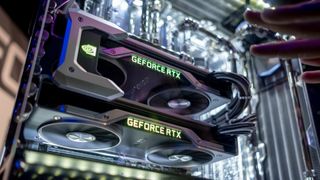
2. Nvidia GeForce RTX 2080 Ti
The best 4K graphics card
Stream Processors: 4,352 | Core Clock: 1,350MHz (1,635MHz boost) | Memory: 11GB GDDR6 | Memory Clock: 14Gbps | Power Connectors: 2 x 8-pin | Outputs: 3 x DisplayPort 1.4, 1 x HDMI 2.0, 1 x USB-C
High fps 4K gaming
Spearheading ray tracing revolution
Extremely expensive
If you need the best graphics card, and compromises aren’t an option, the Nvidia GeForce RTX 2080 Ti might be one of the best graphics cards for you. This is the most powerful graphics card money can buy without going for a professional graphics solution. And, now that games like Battlefield V, Metro Exodus and Shadow of the Tomb Raider actually use the RTX features, there’s never been a better time to jump on the ray tracing bandwagon. Just brace yourself for that lofty price.
Read the full review: Nvidia GeForce RTX 2080 Ti

3. Nvidia GeForce RTX 2070 Super
The best QHD graphics card
Stream processors: 2,560 | Core clock: 1,605 | Memory: 8GB GDDR6 | Memory clock: 14Gbps | Power connectors: 6 pin + 8 pin | Outputs: 1 x DisplayPort, 1 x HDMI, 1 x DVI-DL
Founders Edition cheaper than original 2070
More CUDA cores
1440p gaming with ray tracing
Still kind of expensive
Founders Edition card is heavy
The souped up Nvidia GeForce RTX 2070 Super isn’t just impressive because its a supercharged version of the highly popular RTX 2070, offering excellent 1440p gaming. It’s also impressive as it gives all that power at a very affordable price, making it a compelling purchase for most users, even the budget ones. Plus, if you’re curious about ray tracing, here’s the best card to try it – you don’t have to break open that piggy bank for the RTX 2080 or RTX 2080 Ti anymore.
Read the full review: Nvidia GeForce RTX 2070 Super

(Image credit: Future)
4. Nvidia GeForce RTX 2060
The best Full HD graphics card
Stream Processors: 1,920 | Core Clock: 1,365MHz (1,680MHz boost) | Memory: 6GB GDDR6 | Memory Clock: 14Gbps | Power Connectors: 1 x 8-pin | Outputs: 2 x DisplayPort, 1 x HDMI, 1 x USB Type-C, 1 x DVI-DL
Ready for 4K @ 30fps gaming
Silky ray traced 1080p gaming
Runs much cooler than previous
Slightly pricier than predecessor
RTX heavily impacts performance at QHD and 4K
While the GeForce RTX 2060 Super is currently taking the 1440p gaming world by storm, its predecessor, the RTX 2060, is still king of 1080p gaming. This mid-range GPU will get you in the door with ray tracing maxed out at 1080p. Plus, it is fully capable of delivering 1440p experiences, as well as 4K ones, if you don’t mind the more pedestrian frame rate of 30 fps. And, while this card was pricier at launch than the one it replaced, its excellent 1080p performance should be enough to make that price tag a non-factor.
Read the full review: Nvidia GeForce RTX 2060
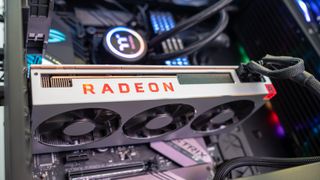
Image credit: TechRadar
5. AMD Radeon VII
The best Full HD graphics card
Stream Processors: 3,840 | Core Clock: 1,400MHz (1,800MHz boost) | Memory: 16GB HBM2 | Memory Clock: 2Gbps | Power Connectors: 2 x 8-pin | Outputs: 3 x DisplayPort 1.4, 1 x HDMI 2.0
Plenty of VRAM
Runs cool
Weak DirectX 12 performance
We’ve been longing for a new high-end graphics card from AMD since 2017’s Radeon Vega 64, but a lot has happened in the graphics market since then – namely Nvidia Turing. With the AMD Radeon VII, Team Red attempted to reclaim a piece of the high-end graphics pie, and it largely succeeded. The AMD Radeon VII holds its own in 4K gaming, but it particularly excels in content creation. Packed with 16GB of HBM2 memory, the AMD Radeon VII can compete with much pricier creative-focused competitors, making it one of the best graphics cards 2019 has on offer.
Read the full review: AMD Radeon VII
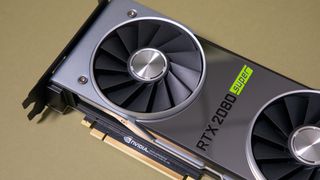
(Image credit: Future)
6. Nvidia GeForce RTX 2080 Super
The best VR graphics card
Stream Processors: 3,072 | Core Clock: 1,650MHz (1,815MHz boost) | Memory: 8GB GDDR6 | Memory Clock: 15.5Gbps | Power Connectors: 1 x 8-pin, 1 x 6-pin | Outputs: 3 x DisplayPort, 1 x HDMI 2.0b, 1 x DVI-DL
Great 1440p and 4K gaming performance
Cheaper than original RTX 2080
FrameView software is useful
Still expensive
Minimal performance gains over RTX 2080
If you’re all about the best VR games, you’re going to need the best graphics cards to do the job. And, nowadays, that honor goes to the Nvidia GeForce RTX 2080 Super. VR-ready and packed with the latest Turing architecture, you won’t have to worry about a choppy VR experience that will make you sick. Outside of VR, it should also be able to handle all your favorite PC games at 1440p and 4K without breaking a sweat. The best part might just be that it’s a lot cheaper than the RTX 2080, offering a much better value.
Read the full review: Nvidia GeForce RTX 2080 Super
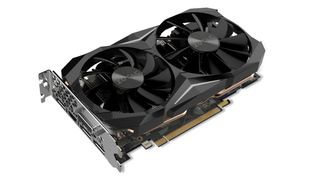
Image credit: Zotac
7. Zotac GeForce GTX 1080 Ti Mini
The best mini graphics card
Stream processors: 3,584 | Core clock: 1,506 | Memory: 11GB GDDR5X | Memory clock: 10Gbps | Power connectors: 2 x 8-pin | Outputs: 3 x DisplayPort 1.4, 1 x HDMI 2.0b, 1 x DL-DVI-D
World’s smallest 1080 Ti
SLI support
Inferior performance
Runs hot and loud
Setting out to build a microATX or a mini-ITX gaming PC? You shouldn’t have to settle for a low-end GPU. Go for mini graphics cards like the Zotac GeForce GTX 1080 Ti Mini instead. It’s not the latest and greatest GPU out there anymore, but the 1080 Ti still has a lot of juice, and it’s among the best graphics cards to power your microATX. And, when you can get that power in a card that’s only 211 x 125 x 41mm, the small loss in performance is completely worth the beautiful mini PC you’ll get.

Image credit: Gigabyte
8. Gigabyte GeForce GTX 1660 OC 6G
The best Budget graphics card:
Stream Processors: 1,408 | Core Clock: 1,530MHz | Memory: 6GB GDDR5 | Memory Speed: 8Gbps | Power Connectors: 1 x 8-pin | Outputs: 3 x DisplayPort 1.4, 1 x HDMI 2.0
Extremely affordable
Great entry-level performance
GDDR5 memory
With all those fancy (read: pricey) graphics cards dominating the market, the budget-friendlier products sometimes go unnoticed. That’s a shame, especially because cards like the Nvidia GeForce GTX 1660 deserves its turn in the spotlight for delivering excellent 1080p performance at a very affordable price. With the Gigabyte GeForce GTX 1660 OC 6G, you’re also getting a healthy factory overclock and all the outputs you’ll ever need, so you can play all your favorite games with several monitors attached. We’d call that a bargain, maybe even the best we’ve ever had, and it certainly warrants a spot in our best graphics cards list.
Read the full review: Gigabyte GeForce GTX 1660 OC 6G

(Image credit: TechRadar)
9. PNY GeForce GTX 1660 Ti XLR8 Gaming OC
The best eSports graphics card
Stream Processors: 1,536 | Core Clock: 1,500MHz | Memory: 6GB GDDR6 | Memory Speed: 12Gbps | Power Connectors: 1 x 8-pin | Outputs: 1 x DisplayPort 1.4, 1 x HDMI 2.0, 1 x DVI
Affordable
Excellent 1080p performance
Limited memory bandwidth
When Nvidia first rolled out its Turing lineup, it was hard to find a model that didn’t cost an arm and a leg. However, with the launch of the Nvidia GeForce GTX 1660 Ti – more specifically, the PNY XLR8 Gaming OC model – next-generation performance became accessible to everyone. You won’t be able to do 4K 60 fps gaming with this card, but it’s one of the best graphics cards for anyone still using a 1080p panel, and it can handle most esports games well above 60fps. At that resolution, you’ll have trouble running into any title that will slow you down.
Read the full review: PNY GeForce GTX 1660 Ti XLR8 Gaming OC
Images Credit: TechRadar
Be the first to comment